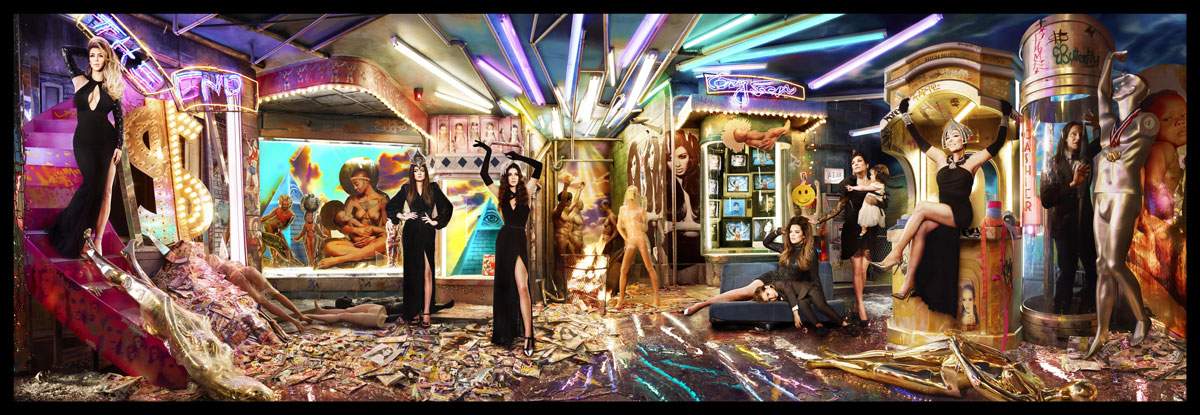From April 18 to June 18, 2019, the Mucciaccia Gallery in Rome hosts the exhibition David LaChapelle, dedicated to the American artist David LaChapelle (Fairfield, 1963), among the most appreciated and recognized artists in the world. On display are thirty-four works that trace his entire production from the 1980s, when he moved away from the world of magazines and advertising to approach art, to his most recent works.
LaChapelle’s works are famous for their Hawaiian atmospheres, unexpected landscapes, mythological figures and dreamlike suggestions: all this repertoire will also be seen in the Rome exhibition, which proceeds backwards in time, since the itinerary begins with the latest works, New World, Lost and Found and Behold (these are photos taken in 2017 in the Hawaiian rainforest, dense with mysticism and spirituality), and then moves on to some works of recent years, made in Los Angeles, such as the two large panels of the Aristocracy series (2014), the monumental Showtime at the Apocalypse (2013), the famous Christmas portrait of the Kardashian family, the Landscapes, the floral Earth Laughs in Flowers and Rape of Africa (2009), the latter a provocative work against the violence suffered by the African continent, which gives the title to the project of the same name presented in 2008.
From 2007, the turning point in LaChapelle’s production, is the series The del uge and the work After the deluge, inspired by a vision of the Sistine Chapel. The reference to Michelangelo’s masterpiece is mixed with that of consumer society brands, generating an apocalyptic vision with an ending where objects, works of art and people appear submerged by water, as in Cathedral, Statue and Awakened. Concluding the exhibition are the series of photographs taken between 1984 and 2009 that look at the world of entertainment and Hollywood stars, such as the three portraits of Michael Jackson celebrating his media beatification, the Hollywood one of Faye Dunaway in Day of the Locust (1996), Dynamic Nude and the only black-and-white photograph taken in New York: Good News for Modern Man from 1984.
Parallel to LaChapelle’s exhibition, the Mucciaccia Contemporary space opens, on the same dates, the exhibition Aftermodernism. A Perspective on Contemporary Art, with ten works by James Busby (Rock Hill, 1973) and fifteen by Justin Samson (Milford, 1979): curated by Cesare Biasini Selvaggi, the exhibition aims to present in Italy a new group of international artists (mainly American or residing in the U.S., but with a fair presence of Europeans as well) gathered under the acronym Aftermodernism, by collector Hubert Neumann, in possession of a collection of more than 2.600 works of modern and contemporary art (from Picasso to Léger, Giacometti to Kandinsky to Basquiat and Koons) inherited from his father Morton and increased over time: in recent years his attention as a collector has focused on a group of artists (mostly generation of the 1970s, 1980s and 1990s), currently about 40 in all, in whom Neumann sees what for him is a real new artistic current in which to invest, defined precisely as Aftermodernism, of which James Busby and Justin Samson are the first exponents to be presented in Italy.
LaChapelle’s exhibition opens Monday through Saturday, 10 a.m. to 7 p.m., while Aftermodernism is open Tuesday through Saturday, 10:30 a.m. to 7 p.m. Admission is free. A book with images from the exhibition will be published by Carlo Cambi Editore on the occasion of the LaChapelle review. Same publisher also for the Aftermodernism catalog. More information can be found on the Mucciaccia Gallery website.
Pictured: David LaChapelle, Showtime at the Apocalypse. Los Angeles 2013. Kardashian Christmas (2013; chromogenic print, 101.6 x 306.71 cm)
 |
| David LaChapelle on display in Rome. 34 works from the 1980s to the present |
Warning: the translation into English of the original Italian article was created using automatic tools. We undertake to review all articles, but we do not guarantee the total absence of inaccuracies in the translation due to the program. You can find the original by clicking on the ITA button. If you find any mistake,please contact us.